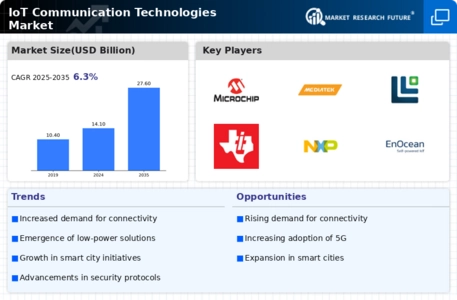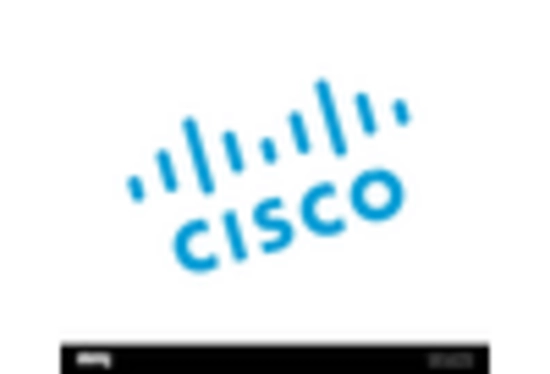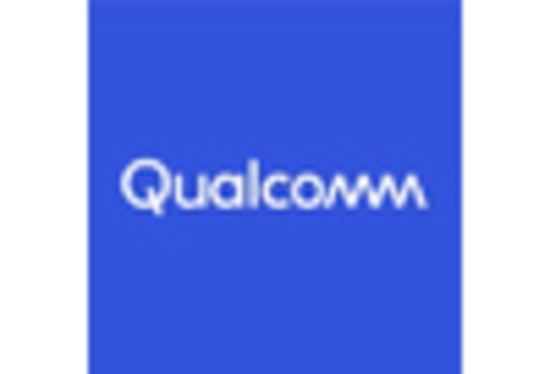-
EXECUTIVE SUMMARY
-
MARKET INTRODUCTION
-
Definition
-
Scope of the Study
- Research Objective
- Assumptions
- Limitations
-
RESEARCH METHODOLOGY
-
Overview
-
Data Mining
-
Secondary Research
-
Primary Research
- Primary Interviews and Information Gathering Process
- Breakdown of Primary Respondents
-
Forecasting Modality
-
Market Size Estimation
- Bottom-Up Approach
- Top-Down Approach
-
Data Triangulation
-
Validation
-
MARKET DYNAMICS
-
Overview
-
Drivers
-
Restraints
-
Opportunities
-
MARKET FACTOR ANALYSIS
-
Value Chain Analysis
-
Porter’s Five Forces Analysis
- Bargaining Power of Suppliers
- Bargaining Power of Buyers
- Threat of New Entrants
- Threat of Substitutes
- Intensity of Rivalry
-
COVID-19 Impact Analysis
- Market Impact Analysis
- Regional Impact
- Opportunity and Threat Analysis
-
GLOBAL IOT COMMUNICATION TECHNOLOGIES MARKET, BY TYPE
-
Overview
-
Wi-Fi
-
Bluetooth
-
Zigbee
-
Others
-
GLOBAL IOT COMMUNICATION TECHNOLOGIES MARKET, BY END-USE
-
Overview
-
Aerospace & Defense
-
Automotive
-
Information and Communication Technology
-
Automation
-
Power and Energy
-
Healthcare
-
GLOBAL IOT COMMUNICATION TECHNOLOGIES MARKET, BY REGION
-
Overview
-
North America
- U.S.
- Canada
-
Europe
- Germany
- France
- U.K
- Italy
- Spain
- Rest of Europe
-
Asia-Pacific
- China
- India
- Japan
- South Korea
- Australia
- Rest of Asia-Pacific
-
Rest of the World
- Middle East
- Africa
- Latin America
-
COMPETITIVE LANDSCAPE
-
Overview
-
Competitive Analysis
-
Market Share Analysis
-
Major Growth Strategy in the Global IoT Communication Technologies Market,
-
Competitive Benchmarking
-
Leading Players in Terms of Number of Developments in the Global IoT Communication Technologies Market,
-
Key developments and Growth Strategies
- New TYPE Launch/End-Use Deployment
- Merger & Acquisitions
- Joint Ventures
-
Major Players Financial Matrix
- Sales & Operating Income, 2022
- Major Players R&D Expenditure. 2022
-
COMPANY PROFILES
-
Microchip Technology
- Company Overview
- Financial Overview
- Type Offered
- Key Developments
- SWOT Analysis
- Key Strategies
-
MediaTek
- Company Overview
- Financial Overview
- Type Offered
- Key Developments
- SWOT Analysis
- Key Strategies
-
Telit
- Company Overview
- Financial Overview
- Type Offered
- Key Developments
- SWOT Analysis
- Key Strategies
-
Link Labs
- Company Overview
- Financial Overview
- Type Offered
- Key Developments
- SWOT Analysis
- Key Strategies
-
Texas Instruments
- Company Overview
- Financial Overview
- Type Offered
- Key Developments
- SWOT Analysis
- Key Strategies
-
NXP Semiconductors
- Company Overview
- Financial Overview
- Type Offered
- Key Developments
- SWOT Analysis
- Key Strategies
-
EnOcean
- Company Overview
- Financial Overview
- Type Offered
- Key Developments
- SWOT Analysis
- Key Strategies
-
Sequans Communications
- Company Overview
- Financial Overview
- Type Offered
- Key Developments
- SWOT Analysis
- Key Strategies
-
Gemalto
- Company Overview
- Financial Overview
- Type Offered
- Key Developments
- SWOT Analysis
- Key Strategies
-
STMicroelectronics
- Company Overview
- Financial Overview
- Type Offered
- Key Developments
- SWOT Analysis
- Key Strategies
-
APPENDIX
-
References
-
Related Reports
-
-
LIST OF TABLES
-
GLOBAL IOT COMMUNICATION TECHNOLOGIES MARKET, SYNOPSIS, 2025-2034
-
GLOBAL IOT COMMUNICATION TECHNOLOGIES MARKET, ESTIMATES & FORECAST, 2025-2034 (USD BILLION)
-
GLOBAL IOT COMMUNICATION TECHNOLOGIES MARKET, BY TYPE , 2025-2034 (USD BILLION)
-
GLOBAL IOT COMMUNICATION TECHNOLOGIES MARKET, BY END-USE, 2025-2034 (USD BILLION)
-
NORTH AMERICA IOT COMMUNICATION TECHNOLOGIES MARKET, BY TYPE , 2025-2034 (USD BILLION)
-
NORTH AMERICA IOT COMMUNICATION TECHNOLOGIES MARKET, BY END-USE, 2025-2034 (USD BILLION)
-
NORTH AMERICA IOT COMMUNICATION TECHNOLOGIES MARKET, BY COUNTRY, 2025-2034 (USD BILLION)
-
U.S. IOT COMMUNICATION TECHNOLOGIES MARKET, BY TYPE , 2025-2034 (USD BILLION)
-
U.S. IOT COMMUNICATION TECHNOLOGIES MARKET, BY END-USE, 2025-2034 (USD BILLION)
-
CANADA IOT COMMUNICATION TECHNOLOGIES MARKET, BY TYPE , 2025-2034 (USD BILLION)
-
CANADA IOT COMMUNICATION TECHNOLOGIES MARKET, BY END-USE, 2025-2034 (USD BILLION)
-
EUROPE IOT COMMUNICATION TECHNOLOGIES MARKET, BY TYPE , 2025-2034 (USD BILLION)
-
EUROPE IOT COMMUNICATION TECHNOLOGIES MARKET, BY END-USE, 2025-2034 (USD BILLION)
-
EUROPE IOT COMMUNICATION TECHNOLOGIES MARKET, BY COUNTRY, 2025-2034 (USD BILLION)
-
GERMANY IOT COMMUNICATION TECHNOLOGIES MARKET, BY TYPE , 2025-2034 (USD BILLION)
-
GERMANY IOT COMMUNICATION TECHNOLOGIES MARKET, BY END-USE, 2025-2034 (USD BILLION)
-
FRANCE IOT COMMUNICATION TECHNOLOGIES MARKET, BY TYPE , 2025-2034 (USD BILLION)
-
FRANCE IOT COMMUNICATION TECHNOLOGIES MARKET, BY END-USE, 2025-2034 (USD BILLION)
-
ITALY IOT COMMUNICATION TECHNOLOGIES MARKET, BY TYPE , 2025-2034 (USD BILLION)
-
ITALY IOT COMMUNICATION TECHNOLOGIES MARKET, BY END-USE, 2025-2034 (USD BILLION)
-
SPAIN IOT COMMUNICATION TECHNOLOGIES MARKET, BY TYPE , 2025-2034 (USD BILLION)
-
SPAIN IOT COMMUNICATION TECHNOLOGIES MARKET, BY END-USE, 2025-2034 (USD BILLION)
-
U.K IOT COMMUNICATION TECHNOLOGIES MARKET, BY TYPE , 2025-2034 (USD BILLION)
-
U.K IOT COMMUNICATION TECHNOLOGIES MARKET, BY END-USE, 2025-2034 (USD BILLION)
-
REST OF EUROPE IOT COMMUNICATION TECHNOLOGIES MARKET, BY TYPE , 2025-2034 (USD BILLION)
-
REST OF EUROPE IOT COMMUNICATION TECHNOLOGIES MARKET, BY END-USE, 2025-2034 (USD BILLION)
-
ASIA PACIFIC IOT COMMUNICATION TECHNOLOGIES MARKET, BY TYPE , 2025-2034 (USD BILLION)
-
ASIA PACIFIC IOT COMMUNICATION TECHNOLOGIES MARKET, BY END-USE, 2025-2034 (USD BILLION)
-
ASIA PACIFIC IOT COMMUNICATION TECHNOLOGIES MARKET, BY COUNTRY, 2025-2034 (USD BILLION)
-
JAPAN IOT COMMUNICATION TECHNOLOGIES MARKET, BY TYPE , 2025-2034 (USD BILLION)
-
JAPAN IOT COMMUNICATION TECHNOLOGIES MARKET, BY END-USE, 2025-2034 (USD BILLION)
-
CHINA IOT COMMUNICATION TECHNOLOGIES MARKET, BY TYPE , 2025-2034 (USD BILLION)
-
CHINA IOT COMMUNICATION TECHNOLOGIES MARKET, BY END-USE, 2025-2034 (USD BILLION)
-
INDIA IOT COMMUNICATION TECHNOLOGIES MARKET, BY TYPE , 2025-2034 (USD BILLION)
-
INDIA IOT COMMUNICATION TECHNOLOGIES MARKET, BY END-USE, 2025-2034 (USD BILLION)
-
AUSTRALIA IOT COMMUNICATION TECHNOLOGIES MARKET, BY TYPE , 2025-2034 (USD BILLION)
-
AUSTRALIA IOT COMMUNICATION TECHNOLOGIES MARKET, BY END-USE, 2025-2034 (USD BILLION)
-
SOUTH KOREA IOT COMMUNICATION TECHNOLOGIES MARKET, BY TYPE , 2025-2034 (USD BILLION)
-
SOUTH KOREA IOT COMMUNICATION TECHNOLOGIES MARKET, BY END-USE, 2025-2034 (USD BILLION)
-
REST OF ASIA-PACIFIC IOT COMMUNICATION TECHNOLOGIES MARKET, BY TYPE , 2025-2034 (USD BILLION)
-
REST OF ASIA-PACIFIC IOT COMMUNICATION TECHNOLOGIES MARKET, BY END-USE, 2025-2034 (USD BILLION)
-
REST OF WORLD IOT COMMUNICATION TECHNOLOGIES MARKET, BY TYPE , 2025-2034 (USD BILLION)
-
REST OF WORLD IOT COMMUNICATION TECHNOLOGIES MARKET, BY END-USE, 2025-2034 (USD BILLION)
-
REST OF WORLD IOT COMMUNICATION TECHNOLOGIES MARKET, BY COUNTRY, 2025-2034 (USD BILLION)
-
MIDDLE EAST IOT COMMUNICATION TECHNOLOGIES MARKET, BY TYPE , 2025-2034 (USD BILLION)
-
MIDDLE EAST IOT COMMUNICATION TECHNOLOGIES MARKET, BY END-USE, 2025-2034 (USD BILLION)
-
AFRICA IOT COMMUNICATION TECHNOLOGIES MARKET, BY TYPE , 2025-2034 (USD BILLION)
-
AFRICA IOT COMMUNICATION TECHNOLOGIES MARKET, BY END-USE, 2025-2034 (USD BILLION)
-
LATIN AMERICA IOT COMMUNICATION TECHNOLOGIES MARKET, BY TYPE , 2025-2034 (USD BILLION)
-
LATIN AMERICA IOT COMMUNICATION TECHNOLOGIES MARKET, BY END-USE, 2025-2034 (USD BILLION)
-
-
LIST OF FIGURES
-
RESEARCH PROCESS
-
MARKET STRUCTURE FOR THE GLOBAL IOT COMMUNICATION TECHNOLOGIES MARKET
-
MARKET DYNAMICS FOR THE GLOBAL IOT COMMUNICATION TECHNOLOGIES MARKET
-
GLOBAL IOT COMMUNICATION TECHNOLOGIES MARKET, SHARE (%), BY TYPE , 2022
-
GLOBAL IOT COMMUNICATION TECHNOLOGIES MARKET, SHARE (%), BY END-USE, 2022
-
GLOBAL IOT COMMUNICATION TECHNOLOGIES MARKET, SHARE (%), BY REGION, 2022
-
NORTH AMERICA: IOT COMMUNICATION TECHNOLOGIES MARKET, SHARE (%), BY REGION, 2022
-
EUROPE: IOT COMMUNICATION TECHNOLOGIES MARKET, SHARE (%), BY REGION, 2022
-
ASIA-PACIFIC: IOT COMMUNICATION TECHNOLOGIES MARKET, SHARE (%), BY REGION, 2022
-
REST OF THE WORLD: IOT COMMUNICATION TECHNOLOGIES MARKET, SHARE (%), BY REGION, 2022
-
GLOBAL IOT COMMUNICATION TECHNOLOGIES MARKET: COMPANY SHARE ANALYSIS, 2022 (%)
-
MICROCHIP TECHNOLOGY : FINANCIAL OVERVIEW SNAPSHOT
-
MICROCHIP TECHNOLOGY : SWOT ANALYSIS
-
MEDIATEK : FINANCIAL OVERVIEW SNAPSHOT
-
MEDIATEK : SWOT ANALYSIS
-
TELIT: FINANCIAL OVERVIEW SNAPSHOT
-
TELIT: SWOT ANALYSIS
-
LINK LABS: FINANCIAL OVERVIEW SNAPSHOT
-
LINK LABS: SWOT ANALYSIS
-
TEXAS INSTRUMENTS.: FINANCIAL OVERVIEW SNAPSHOT
-
TEXAS INSTRUMENTS.: SWOT ANALYSIS
-
NXP SEMICONDUCTORS: FINANCIAL OVERVIEW SNAPSHOT
-
NXP SEMICONDUCTORS: SWOT ANALYSIS
-
ENOCEAN: FINANCIAL OVERVIEW SNAPSHOT
-
ENOCEAN: SWOT ANALYSIS
-
SEQUANS COMMUNICATIONS: FINANCIAL OVERVIEW SNAPSHOT
-
SEQUANS COMMUNICATIONS: SWOT ANALYSIS
-
GEMALTO: FINANCIAL OVERVIEW SNAPSHOT
-
GEMALTO: SWOT ANALYSIS
-
STMICROELECTRONICS: FINANCIAL OVERVIEW SNAPSHOT
-
STMSICROELECTRONICS: SWOT ANALYSIS








Leave a Comment